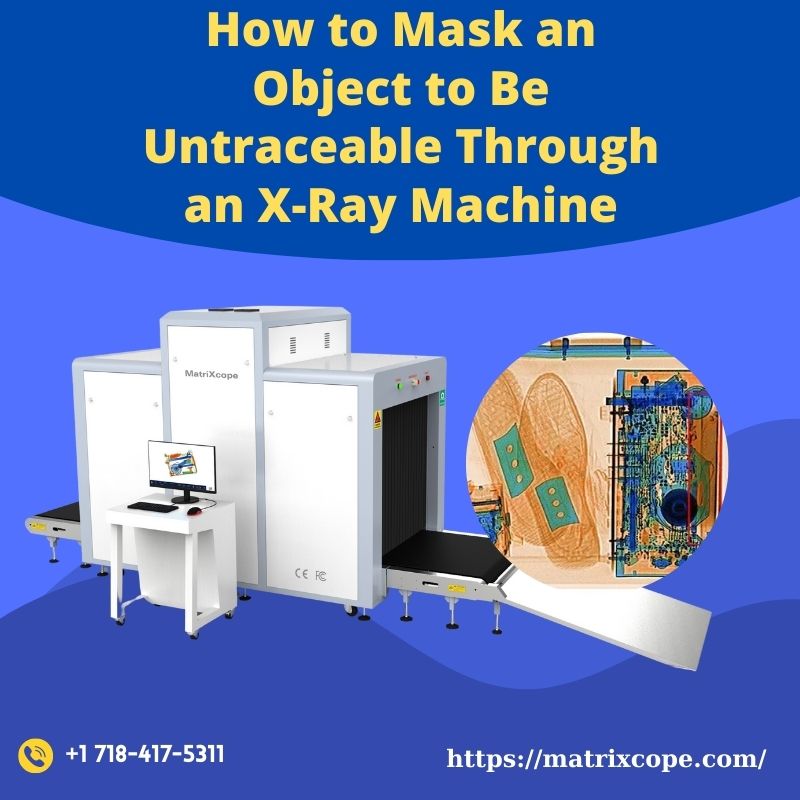Blogs
How to Mask an Object to Be Untraceable Through an X-Ray Machine
X-ray machines are widely used for security screening in airports, government buildings, and various other secure locations. These machines are designed to detect concealed items by producing images based on the density and composition of objects.
However, there are scenarios where individuals might seek to mask an object to prevent it from being detected or traced by an X-ray machine. This could involve legitimate privacy concerns, but it can also raise ethical and legal issues.
Techniques for Masking Objects from X-Ray Detection

Using Low-Density Materials
Objects made from low-density materials like plastics, glass, or certain types of ceramics can sometimes appear less prominently on X-ray scans. These materials absorb fewer X-rays compared to metals, making them harder to detect.
Limitations: Security professionals are trained to recognize the shape and presence of low-density objects, and modern X-ray machines can enhance images to reveal these items.
Encasing in Organic Materials
Encasing an object in organic materials, such as food or clothing, can help obscure it. Organic materials can absorb X-rays differently than inorganic ones, making the object blend into the background.
Limitations: Security scanners often have settings to differentiate between organic and inorganic materials, so this method may not always be effective.
Using Shielding or Absorptive Materials
Shielding materials like lead or barium can block X-rays. Wrapping an object in a thin layer of such materials can prevent it from being detected.
Limitations: The use of such shielding materials is often a red flag for security personnel, who may conduct further inspections if they detect anomalies.
Shaping and Positioning
Placing an object in a shape that mimics common, innocuous items can help avoid suspicion. For example, embedding a prohibited item within an everyday object that is expected in the scanned area might reduce scrutiny.
Limitations: Security personnel are trained to identify and investigate unusual shapes and contents, especially if something appears out of place.
Using Advanced Coatings
Advanced coatings that scatter or absorb X-rays differently can be applied to objects to make them less visible on X-ray scans. These coatings are typically used in specialized applications and may not be readily available.
Limitations: High-end security systems may still detect inconsistencies, and the presence of unusual materials might prompt further examination.
Ethical and Legal Considerations
Legal Implications: Attempting to mask an object from detection by X-ray machines is illegal and punishable by law, especially if it involves smuggling contraband, weapons, or other prohibited items.
Ethical Considerations: There are ethical concerns around privacy and personal freedom. However, security protocols are in place to protect public safety, and attempting to bypass these protocols undermines these efforts.
Security Enhancements: Modern X-ray machines are equipped with sophisticated algorithms and AI to detect suspicious items, making it increasingly difficult to successfully mask objects.
Related FAQs
1. Can you completely hide an object from an X-ray machine?
It is extremely difficult to completely hide an object from a modern X-ray machine due to advanced detection technologies and the training of security personnel. Attempting to do so is also illegal and unethical.
2. What materials can an X-ray machine not see through?
X-ray machines can see through most materials, but their effectiveness varies with density. High-density materials like lead can block X-rays, but their presence usually triggers further investigation.
3. Why do X-ray machines detect some materials better than others?
X-ray machines detect materials based on their density and atomic number. Higher density materials and those with a higher atomic number absorb more X-rays and are thus more easily detected.
4. Are there legitimate reasons to want to obscure an object from X-ray detection?
There may be privacy concerns or legitimate reasons to protect sensitive information, but these must be balanced against security protocols and legal requirements. It is always best to discuss any concerns with security personnel in advance.
5. How do modern X-ray machines improve detection?
Modern X-ray machines use advanced imaging techniques, including dual-energy X-rays and AI algorithms, to enhance image clarity and detect anomalies. This makes it harder to obscure objects from detection.
Conclusion
While there are various methods that can be used to try to mask an object from X-ray detection, modern security measures and technologies make it highly challenging and illegal to do so. The balance between privacy and security is crucial, and any attempts to bypass security protocols should be reconsidered in light of the legal and ethical implications.
